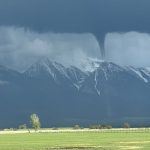Helena, Montana — State, federal, and local officials said on Tuesday that they are well on their way to preparing for Montana’s wildfire season even though it is still early in the year.
“All in all, I think we’re in good shape,” said Rich Cowger, chief of Columbus Fire Rescue and president of the Montana State Fire Chiefs Association. “We’ll just see what Mother Nature does to us, and we can hope for the best.”
The annual fire season briefing was given to Governor Greg Gianforte in the State Capitol by organizations like the U.S. Forest Service, the Montana Department of Natural Resources and Conservation, and county fire wardens.
Gianforte, like he has done in recent years, advised leaders to continue their “aggressive attack” by allocating resources to putting out flames as soon as it is safe to do so in an effort to keep them small. The amount of wildfires that leaders have been able to contain to less than ten acres was highlighted.
Chief of the DNRC Fire Protection Bureau Matt Hall stated that more than 80% of the department’s 112 seasonal firefighting positions have already been filled. The state was able to raise the minimum wage this year to $17.55 an hour.
“If folks are still interested in a summer job fighting wildland fire, now’s the time to get their application in, as only a few positions are left open there,” Hall said.
According to Hall, training for seasonal firemen will start in June and last for three to four weeks.
The U.S. Forest Service has reportedly working to raise firefighter pay at the federal level, according to regional forester Leanne Marten. She claimed that while hiring has been difficult at times, it has also been successful. According to Marten, the agency would start the year with around 2,000 people on hand.
The Montana National Guard is once more prepared to help with the response to wildfires. Maj. Gen. Pete Hronek, the adjutant general of the Guard, announced that 1,500 troops and airmen will be made available, with more than 300 of them having already finished “red card training,” a program for becoming certified to fight wildfires. Hronek argued that it was advantageous to complete the training before responding to an emergency.
“Usually they have to come in about three or four days just to get equipped and trained before they can even get out,” he said. “They’re much more excited to be trained and ready to go, so they’re off on duty if called to do that.”
Given that wildfires don’t respect jurisdictional lines, coordination, according to all the authorities present, is still essential.
“While we are looking forward into 2023 and what the season will bring, and we have our predictions – regardless, we are ready and we are prepared to work with you, Governor, and the state and all federal agencies and tribes, to really work across and meet the needs on the ground when it comes to wildfire suppression,” Marten said.



